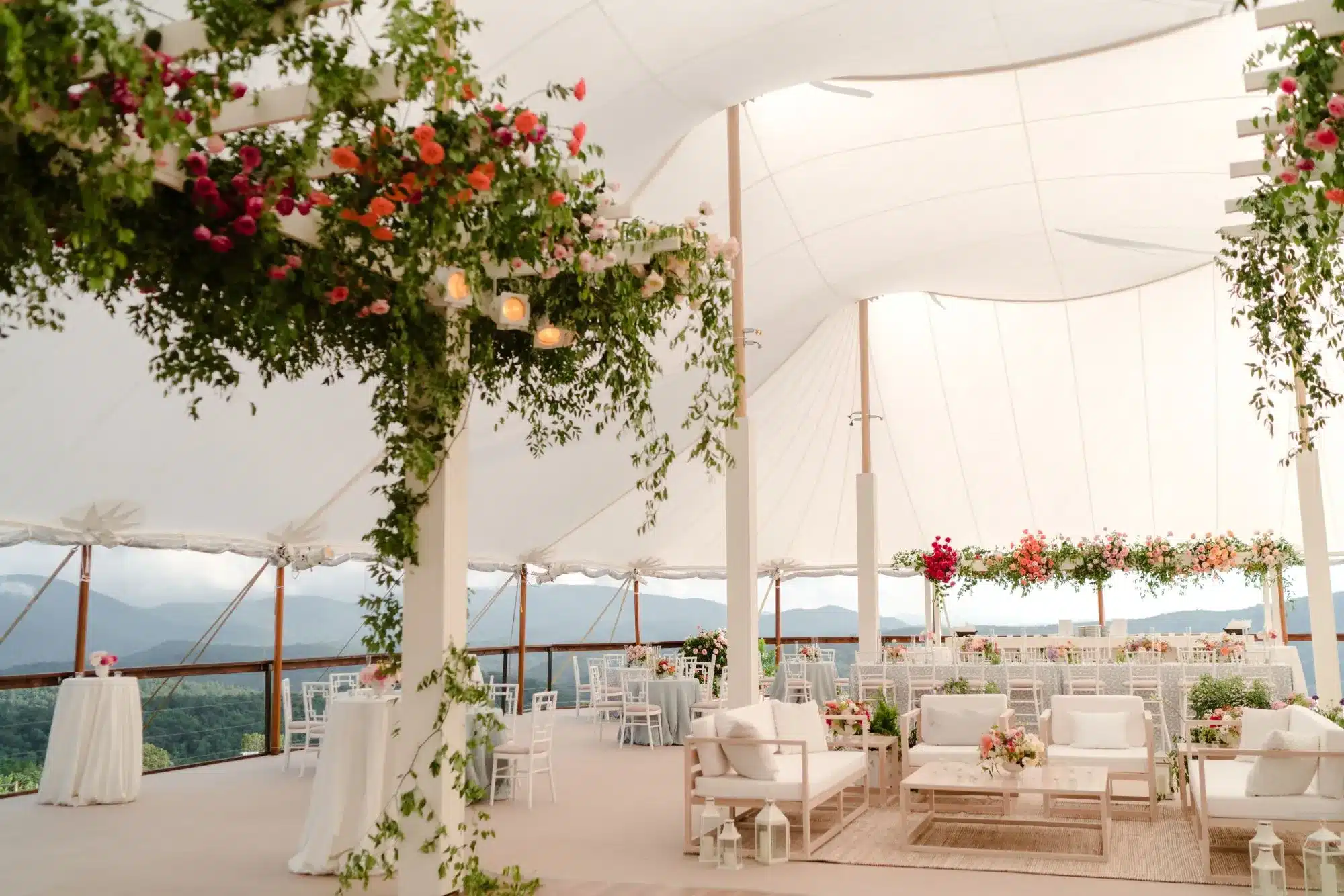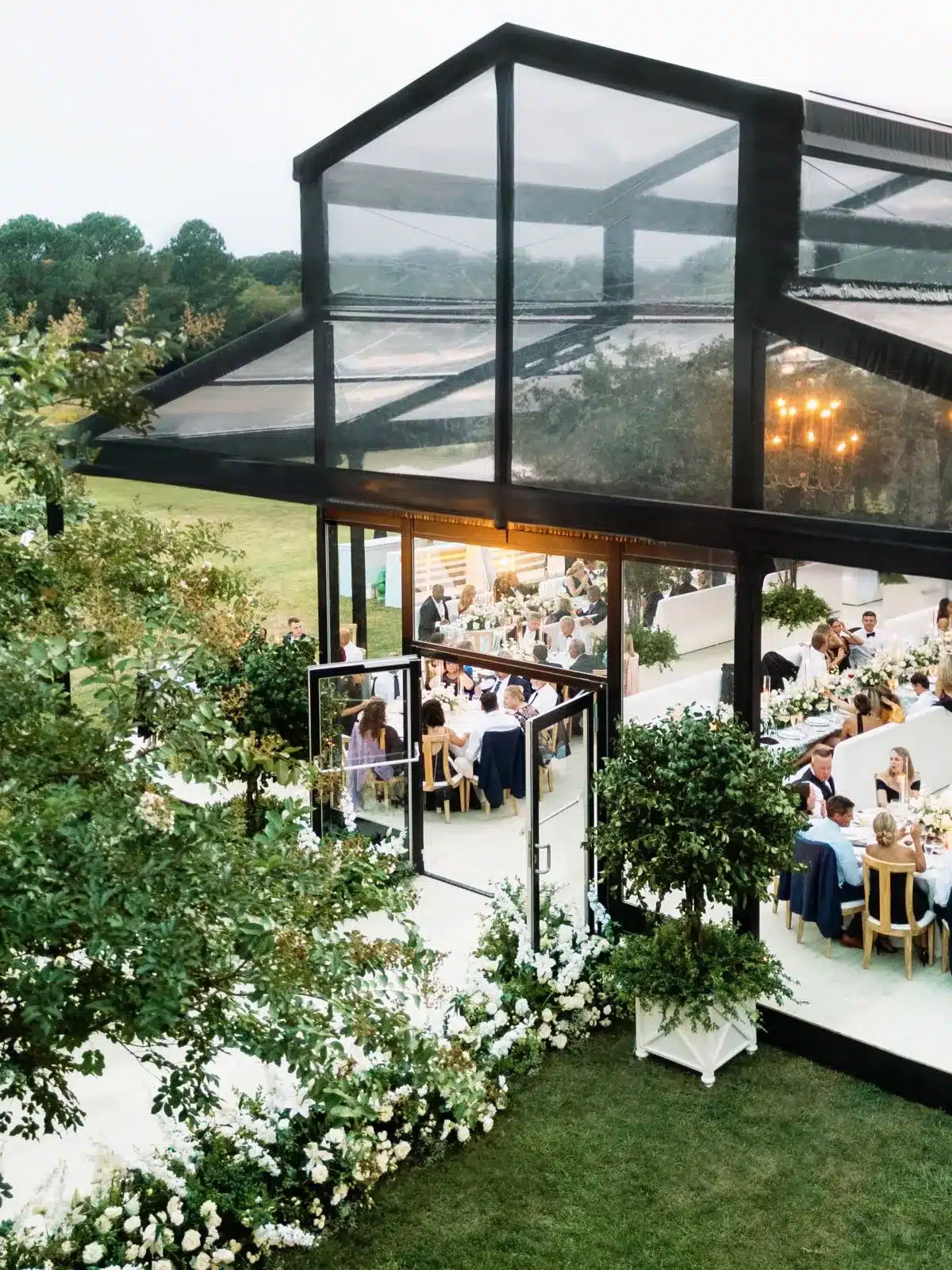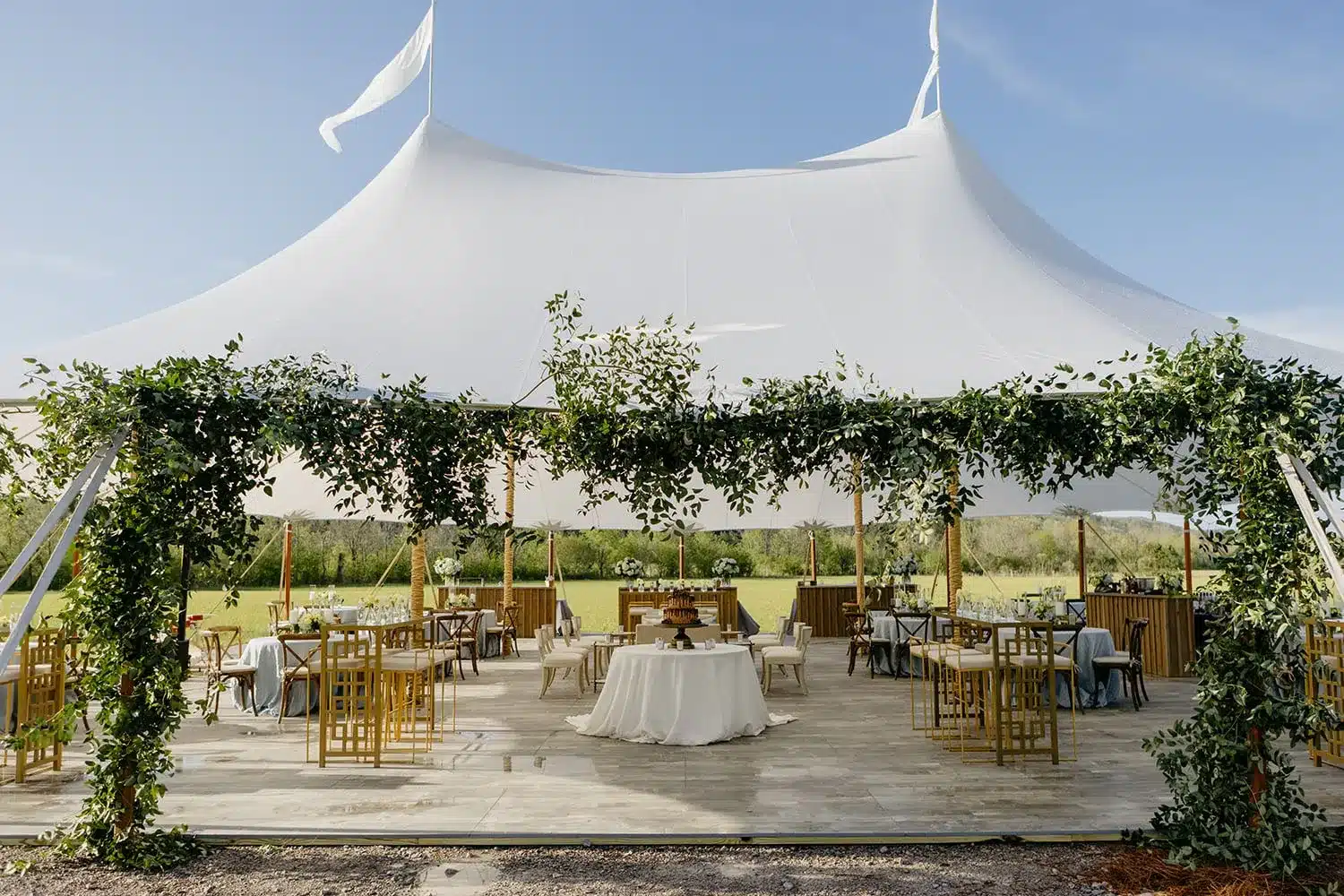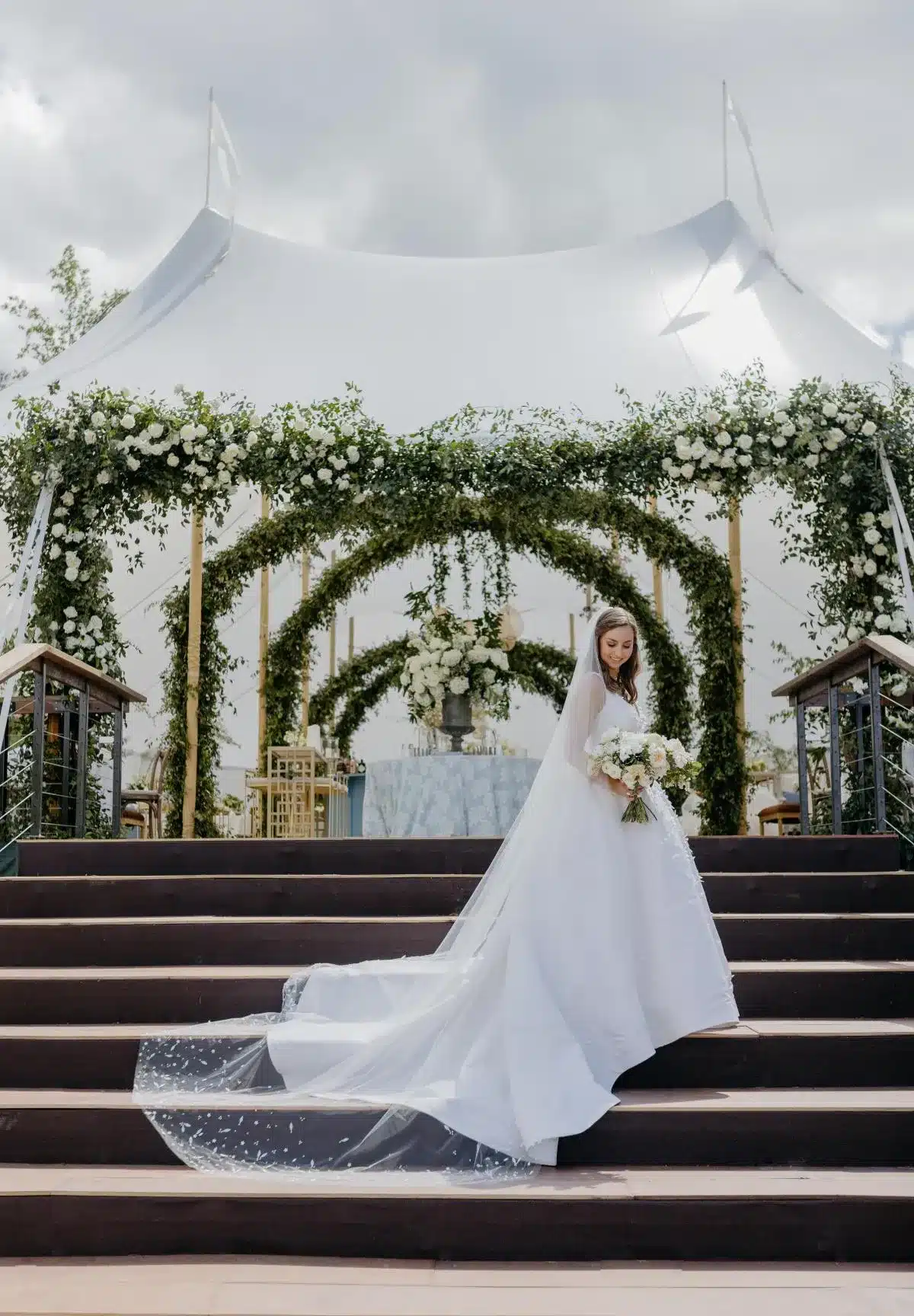Floral design has the power to completely transform a tented venue, turning a simple structure into an elegant and memorable setting. When paired with Skyline Tent Company’s luxury tents, flowers become more than decoration—they frame entrances, highlight ceilings, and create focal points that set the tone for the celebration. From romantic garlands in sailcloth tents to dramatic suspended arrangements in clearspan structures, thoughtful floral artistry enhances both the beauty and function of your event space. This guide explores how different tent types inspire unique floral designs, the most impactful installations to consider, and tips for working with expert florists to bring your vision to life.
Key Takeaways
- Floral arrangements can transform a tented space into a luxurious and welcoming venue.
- Different tent types, like sailcloth and clearspan, shape what floral designs work best.
- Popular floral features include arches, chandeliers, suspended garlands, and centerpieces.
- Lighting and draping play a key role in highlighting floral textures and colors.
- Choosing a florist experienced with tented events ensures safe and seamless installations.
- Seasonal and sustainable flowers are stylish, fresh, and eco-friendly options.
What Defines Luxury Tent Wedding Floral Arrangements and Why They Captivate

Luxury tent wedding floral arrangements are custom compositions of premium blooms and greenery, artfully configured to enhance the structural canvas of high-end tents. By harmonizing color palettes, textures, and spatial flow, these installations transform a tented space into a cohesive, immersive environment that engages guests from ceremony to reception. For instance, a rose and peony garland woven into sailcloth tent beams creates a romantic canopy while accentuating the tent’s graceful curves. Understanding this synergy between floral artistry and tent architecture lays the groundwork for exploring how tailored designs amplify luxury events.
How Do Custom Floral Designs Enhance Luxury Tent Events?
Custom floral designs enhance luxury tent events by tailoring each arrangement to the tent’s proportions, lighting, and theme—ensuring every petal and stem complements the venue’s aesthetic. When florists collaborate with tent providers, they craft installations that align with ceiling height, draping, and structural lines. This partnership transforms a generic rental space into a curated environment, making the floral narrative central to the guest experience and reinforcing brand consistency for corporate galas or cohesive storytelling for bespoke weddings.
Which Tent Types Best Complement High-End Floral Arrangements?
Sailcloth tents, clear span structures, pole tents, and marquees each present unique canvases for florals:
- Sailcloth tents feature translucent peaks that diffuse daylight, ideal for airy, romantic arrangements such as cascading vines and soft-petaled blooms.
- Clear span tents offer unobstructed interiors where structural floral chandeliers and geometric installations draw focus to modern minimalism.
- Pole and marquee tents provide classic supports for grand arches and lush greenery frames that accentuate traditional elegance.
Selecting the right tent type ensures a seamless blend of florals and shelter.
What Are the Key Floral Elements That Create Captivating Tent Decor?
Creating captivating tent decor hinges on harmonizing four core floral elements:
- Suspended installations (floral chandeliers, hanging garlands) that draw the eye upward.
- Grand entrance arches that establish focal points and guest flow.
- Table centerpieces that anchor reception layouts.
- Aisle and stage florals that frame ceremony backdrops.
Combining these elements with strategic lighting and draping yields a multidimensional setting that resonates throughout the event space, guiding guests from entry to celebration.
How Do Different Tent Structures Influence Floral Design Possibilities?

Tent structure dictates suspension points, sightlines, and lighting conditions—directly shaping floral design choices and installation methods. Sailcloth peaks allow soft, organic draping of vines and delicate blossoms, while clear span’s sturdy framework supports statement chandeliers and sculptural greenery. Pole tents with center mast poles require balancing vertical bouquets and ground arrangements to maintain sightlines, whereas marquees benefit from integrated lighting that highlights focal florals. Recognizing these possibilities ensures each tent type becomes a bespoke backdrop for floral creativity.
What Floral Styles Work Best for Sailcloth Tents?
Sailcloth tents inspire romantic, airy floral styles featuring pastel-toned peonies, garden roses, and cascading eucalyptus. Gentle curves of fabric peaks complement soft, undulating garlands that mimic natural vines. Arrangements often use semi-open blooms and delicate filler flowers like waxflower to maintain translucency and float above guest tables, creating a dreamy atmosphere that leverages the tent’s luminous canopy.
How Are Clear Span Tent Floral Installations Designed for Modern Elegance?
Clear span tents enable bold, structural floral installations—such as linear greenery frames and suspended cube chandeliers—thanks to their exposed steel trusses. Florists anchor modular frames directly to rigging points, incorporating orchids, protea, and sculptural foliage for a sleek, contemporary aesthetic. Clean lines and monochromatic palettes reinforce modern elegance while dramatic spotlighting accentuates suspended designs.
What Are Classic Floral Arrangements for Pole and Marquee Tents?
Pole and marquee tents lend themselves to grand, traditional floral concepts: towering urns at entrances, symmetrical archways at altar points, and abundant centerpiece clusters. Rich jewel-tone flowers like dahlias and ranunculus bound together with trailing ivy create an opulent feel. Coordinating color stands ground the design, while uplights around poles highlight canopy fabric and frame guest sightlines.
How Does Tent Draping and Lighting Affect Floral Presentation?
Tent draping and lighting dictate mood and highlight floral textures: soft fabric swags disperse direct light, producing an intimate glow on blush peonies, while pinspot and fairy lighting accentuate crystalline chandeliers. Strategic uplighting behind floral walls or along draped ceilings casts shadows that add depth, making blooms appear to float. Integrating draping plans with floral rigging ensures each installation receives optimal illumination.
What Are the Most Popular Floral Installations for Luxury Tent Events?

The most sought-after floral installations for luxury tent events elevate both design drama and guest engagement. Floral chandeliers suspended from tent peaks transform ceilings into immersive gardens, while hanging garlands weave through beams to guide sightlines. Grand arches welcome guests with lush frames, and bespoke table centerpieces anchor reception layouts with seasonal blooms. Understanding these high-impact options allows event designers to prioritize installations that resonate with the event’s style and scale.
How Do Floral Chandeliers Transform Tent Ceilings?
Floral chandeliers transform tent ceilings by suspending lush assemblages of blooms and greenery above guest tables, creating a floating garden effect. By integrating structural frames wrapped in vines, orchids, and cascading roses, these installations draw attention upward and establish a central focal feature. This vertical dimension expands perceived space and unifies décor elements beneath one botanical canopy.
What Are the Benefits of Hanging Floral Garlands and Suspended Arrangements?
Hanging floral garlands and suspended arrangements provide continuous visual flow throughout a tent, linking ceremony areas to reception zones. These installations soften sharp architectural lines, guide guest movement, and deliver tactile intimacy as guests pass beneath fragrant blooms. Their lightweight structure reduces floor clutter and maintains open layouts—ideal for cocktail areas and dancing space.
How Do Grand Floral Arches and Entrances Set the Event Tone?
Grand floral arches and entrances establish an event’s narrative from the first step inside a tented venue. Archways laden with seasonal blooms, moss, and foliage create immersive transitions that align with an event’s color story and scale. Visitors experience an immediate sense of luxury and thematic cohesion, setting expectations for the ambiance and décor beyond the threshold.
What Styles of Table Centerpieces Elevate Tent Event Tablescapes?
Table centerpieces elevate tent tablescapes when they balance height, proportion, and botanical variety. Low, sprawling designs with garden roses, hydrangeas, and textured greenery foster conversation, while tall compote arrangements and cylinder vases create drama. Mixed heights in clusters guide guest sightlines, and subtle touches—like bud vases or votive clusters—add depth and personal detail to place settings.
How Do You Choose the Right Luxury Tent Event Florist for Bespoke Floral Decor?
Selecting a luxury tent event florist demands attention to qualifications, collaborative process, and synergy with tent providers. The ideal specialist has experience rigging installations for diverse tent types, a portfolio of high-end projects, and the capacity to work alongside tent rental teams to orchestrate seamless setups. Prioritizing expertise in structural florals and project coordination ensures your event design vision becomes reality without compromise.
What Expertise Should You Look for in a Tent Event Florist?
Seek a florist with proven skill in structural installations, knowledge of rigging safety, and strong design sensibility for luxury events. Experience with sailcloth peaks, clear span beams, and marquee draping indicates their ability to customize solutions. Portfolios should showcase varied tent types and highlight creative use of seasonal flowers, proving adaptability and technical proficiency.
How Does the Consultation Process Shape Your Floral Vision?
The consultation process shapes your floral vision by aligning style preferences, event logistics, and budgetary parameters. Florists conduct site assessments—examining ceiling heights, anchor points, and lighting plans—before proposing concept sketches. Collaborative mood boards and 3D renderings refine color palettes and installation scale, ensuring each bloom placement complements tent architecture and guest flow.
Why Is Collaboration Between Tent Providers and Florists Essential?
Collaboration between tent providers and florists is essential because coordinated timing, rigging compatibility, and load calculations determine installation success. Tent teams identify structural limits and anchor locations, while florists design within those parameters. This synergy prevents last-minute challenges, guarantees safety, and integrates décor elements—draping, lighting, and florals—into a cohesive production plan.
Seasonal and Sustainable Floral Choices for Luxury Tent Events
Choosing seasonal flowers ensures your arrangements look fresh, vibrant, and perfectly suited to the time of year. Locally sourced blooms not only support regional growers but also arrive at their peak, lasting longer throughout your celebration. Sustainable choices—like reusing greenery, opting for potted plants, or selecting flowers with a lower environmental impact—allow you to create an elegant design while staying eco-friendly. These thoughtful selections align beautifully with the natural ambiance of sailcloth, clearspan, or marquee tents.
Finding Inspiration for Tent Floral Designs
Looking at real examples is one of the best ways to refine your floral vision. Galleries featuring sailcloth canopies draped in greenery or clearspan ceilings highlighted by suspended blooms reveal just how transformative florals can be in a tented space. Before-and-after imagery also shows the impact of professional design—turning a simple structure into a lush garden setting or a sophisticated reception hall.
The Role of Design Planning Tools
Mood boards and digital mock-ups are valuable in bringing your ideas to life before the event. By combining flower samples, color palettes, and proposed layouts within the tent structure, these tools help planners and florists fine-tune scale, texture, and placement. This collaborative process ensures every floral element enhances the tent’s architecture and flows seamlessly with lighting and décor.
Creating a Cohesive Vision
At Skyline Tent Company, we know the best results come from uniting tent design with floral artistry. By pairing the right seasonal flowers with a tailored tent layout, your event space becomes more than a venue—it becomes an unforgettable experience for every guest.
Conclusion
Luxury floral design brings life, color, and elegance to a tented event, transforming a structure into an unforgettable setting. By pairing the right flowers with the right tent style, you create a cohesive environment that feels both natural and sophisticated. Seasonal and sustainable blooms add freshness and meaning, while careful planning ensures every arrangement enhances the guest experience. At Skyline Tent Company, we collaborate closely with florists and planners to ensure each floral detail aligns seamlessly with our tents, resulting in breathtaking events that leave lasting impressions.
Frequently Asked Questions
What flowers work best for tented weddings?
Seasonal flowers such as roses, peonies, hydrangeas, and greenery are popular choices because they complement tent structures and stay fresh throughout the event.
Can florals be safely suspended inside tents?
Yes. Experienced florists and tent providers work together to secure suspended installations like floral chandeliers or garlands using proper rigging techniques.
How do I choose the right florist for a tented event?
Look for a florist with experience in structural floral installations and a portfolio that includes tented weddings or corporate events. Collaboration with the tent provider is key.
How do flowers enhance a tent wedding?
Flowers add texture, color, and movement that highlight the tent’s architecture. From floral arches at entrances to suspended arrangements above dining spaces, they create a warm, inviting atmosphere that makes the tent feel like a custom-designed venue.
How far in advance should floral planning begin?
Ideally, floral planning should begin at least six months before the event to coordinate with tent design, layout, and seasonal flower availability.

